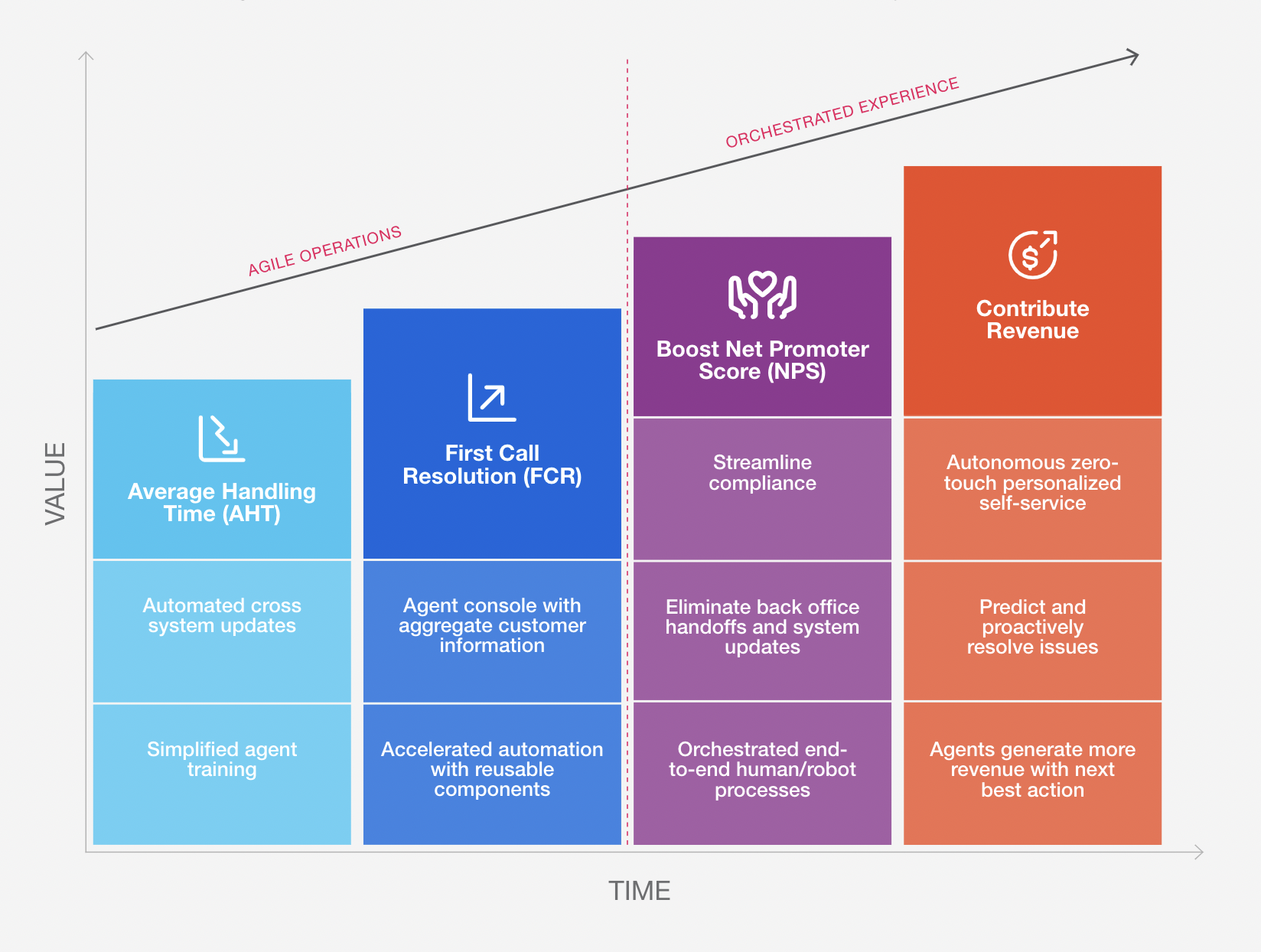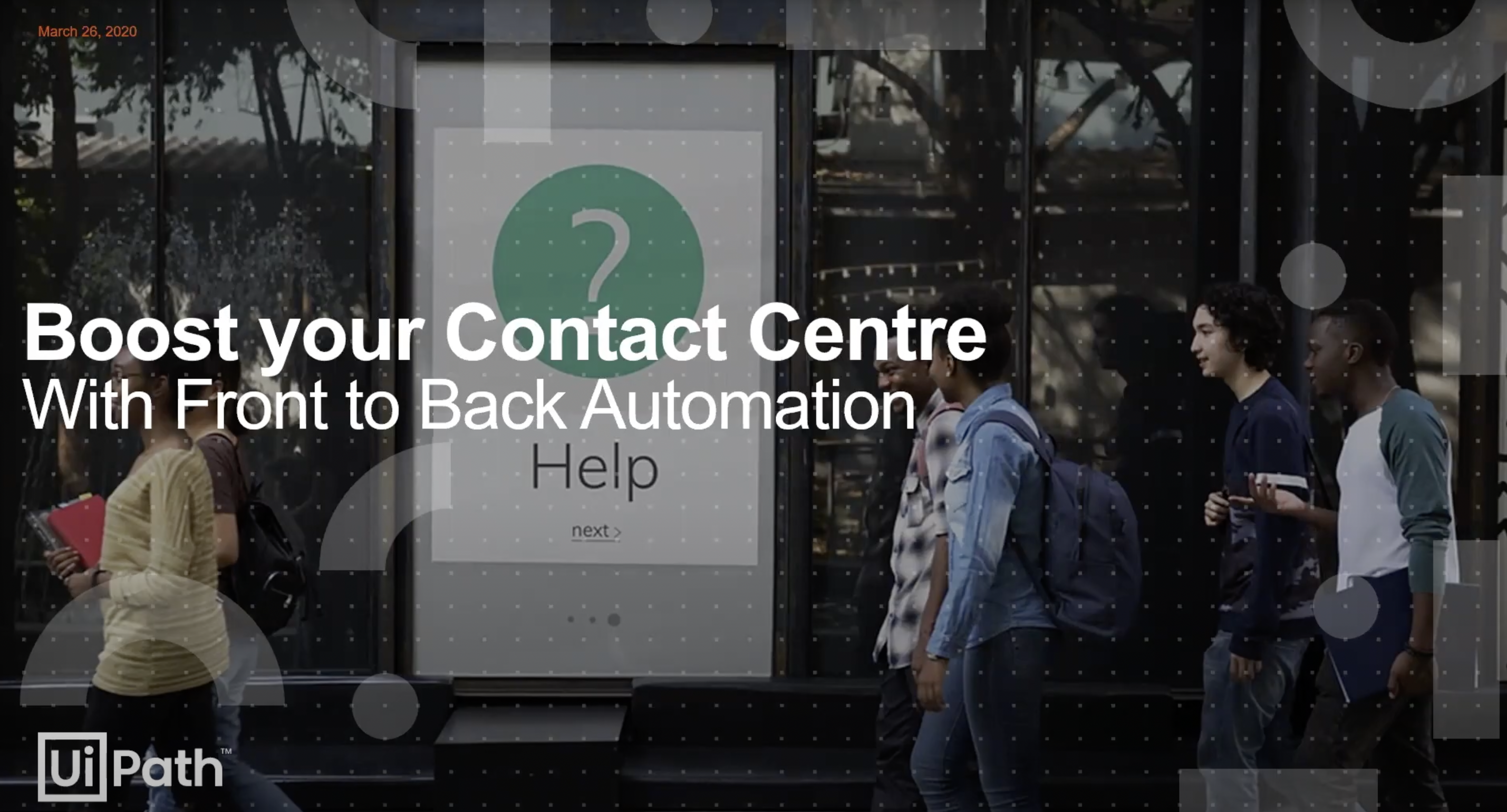The Power of Automation in a Post-Pandemic Contact Center
Share at:

Back in the day, if I called any customer service number and was greeted by “Hello, please listen carefully as our menu options have changed,” my first response was: "Representative."
I wanted to get past the bot as quickly as possible to get to a human. Times have changed. Today, I don't do that anymore because:
There have been marked improvements in call center bots’ ability to fulfill my requests
Often, if I don't select one of the predefined options (i.e., saying “representative” instead), the automated system hangs up on me
While the latter reason is less stellar, it gives us insights into what makes a call center automation exceptional.
In this article I will discuss:
The case for an automated contact center
Lesser-known benefits of automating your contact center (beyond the obvious benefits)
The precise gap that robotic process automation (RPA) fills in a digitally transformed contact center
The case for an automated contact center
The pandemic has had a significant impact on contact centers in the past year and a half. Call volumes at many centers skyrocketed, and many contact center agents had to work remotely. As a result, average handle time (AHT) of calls, abandonment rate, average queue, and hold times all increased.
To address the drastic shifts in demand, many companies turned to automation. We saw unprecedented growth in many tech companies who provide call center solutions, and we also saw an increase in our customers adopting contact center automations to meet their needs.
While I was writing this, I received an email from JetBlue, letting customers know they have increased their contact center capabilities during the pandemic. The email states they now handle over a third of their customer support queries via live chat technologies, and this has helped them reduce call hold times significantly.
Contact center agents often have to navigate multiple systems to look up information to address a caller’s request. With the right technologies, the caller’s identity can be detected before the start of the call, and all information relevant to the caller can be pulled up and consolidated for the agent to view before getting connected. With the accessibility of information to enable the agent, we have seen AHT reduced by as much as 63% with our clients, improving both the customer and agent experience.
Part of the value of call center automations is to help human agents work faster and more efficiently. Another benefit of contact center automation is the ability to address some of the calls completely without needing a human agent to intervene. Specifically, the low-complexity requests, which often make up many of the callers' requests.
Using interactive voice response (IVR), a bot can address simpler contact center issues with self-service tools, while agents can focus on more complex and nuanced issues. IVR is a technology that allows humans to interact with a computer-operated phone system through the use of voice and keypad input.
Kearney, a global management consulting firm, conducted independent research that found:
AI and RPA solutions "can reduce the total amount of time call center agents spend on processes by 25% by 2022 and 40% by 2027"
"Now is the time to invest in contact center technologies as the primary window of opportunity will close by 2022."
Forrester surveyed “decision-makers responsible for contact center technology purchase decisions at their organizations” for a Forrester custom study commissioned by CallMiner. When decision makers were asked what contributed most to the changes they experienced at their organization in 2020, many said employee health concerns about working during the COVID-19 crisis and changes to daily operations, including the shift to a distributed working model. But even more said that the advancement in contact center technologies was what impacted them the most.
Changes to how contact centers operate are inevitable, and many companies have already realized the benefits of automation on call center efficiency.
According to a Harvard Business Review briefing paper, Using Tools and Data Better to Improve the Customer Experience in Contact Centers, "90% of respondents stated that a good experience with a contact center will reinforce their loyalty."
The importance of customer satisfaction is obvious.
In the next section I will go over some of the benefits beyond the obvious.
Creative ways to benefit from an automated contact center
Many contact centers list reducing AHT as the primary benefit of automation. Reducing AHT increases both call center capacity and customer satisfaction. While those are all significant changes, AHT is what I call a ‘first-layer benefit.’
Other obvious first-layer benefits include increasing first call resolution (FCR) rates, improving compliance, reducing errors, increasing customer satisfaction, improving agent experience, and decreasing training and onboarding costs.

The graph above is from the UiPath white paper “Think Automation First to Deliver Exceptional Customer Experiences.” Claim your free copy of the paper for a more in-depth perspective.
A second layer of benefits lies in the ability to collect a plethora of data that would not be possible to collect if human agents had to handle all of the calls manually. This is also where some of the most innovative AI technologies, such as voice analytics and sentiment analysis, come in.
For example, some call centers have dedicated quality assurance (QA) analysts who listen to calls and analyze call conversations to ensure call quality, provide feedback to agents, and collect information from calls that may be beneficial to the organization. With ever-increasing call volumes and limited time, human QA analysts will certainly miss data that AI tools will be able to pick up easily. Voice analytics is a common AI technology that solves this problem. It allows organizations to listen to 100% of the calls, instead of just a small fraction of the calls typically reviewed by human QA analysts. Furthermore, AI-powered voice analytics technology not only analyzes content, but also context and sentiment. AI can capture customers’ emotional and cognitive responses in real time which is important as these sentiments dissipate over time and details of the interaction may be forgotten. As the saying goes, the tone is the message.
The ability to do contextual and sentiment analysis on call conversations provides valuable information beyond customer responses you receive via customer satisfaction (CSAT) or net promoter score (NPS) surveys and scores. Using sentiment analysis, one firm was able to prevent $6 million in lost sales by identifying customers who gave high CSAT and NPS scores yet were at risk of churn. Customer insights like that are a game changer.
Besides sentiment analysis, common data analytics include collecting keyword information to understand customer requests and queries, helping you get ahead of your go-to-market strategy. For example, if a high number of recent calls are about a specific new product or a recent offer that your marketing team has distributed, you can follow up proactively and increase conversion rates.
With the accessibility of data, you will be able to make more informed, data-driven decisions. For example, you can better prioritize customer calls or requests (based on customer loyalty or request urgency), determine what follow-up items to direct to a certain customer, and which adjacent services to recommend to a customer. You can even play different messages to different callers based on an individual caller’s characteristics and history, suggests Chris Recio.
You can customize the call experience to fit different callers’ needs instead of using a cookie-cutter approach. A telecom provider we worked with has been able to drive upsell and cross-sell opportunities using call center robots. The robots offer next best action upsell opportunities to the agent during calls based on information the bots gather within minutes.
All of the above would be nearly impossible to accomplish with a primarily manual contact center.
The power of RPA in a contact center
As you can see, the possibilities are endless. Integration is key in order to automate a call center without having your IT team undergo a heavy development effort.
There are two ways to approach this.
1. Reduce volume of issues routed to human agents
One approach is to implement a computer telephony integration (CTI) such as IVR or a chatbots to address the low-complexity inbound requests and only redirect calls to a human agent if the robot cannot resolve the request by itself. With this approach, the existing CTI and chatbot solutions out there will take care of the conversation flow with the caller, using natural language processing (NLP). Once the connection is made and requests are communicated, these solutions typically use various integrations such as API calls to fulfill the callers’ requests.
Depending on what it takes to fulfill a request, you will likely need to write custom scripts to carry out custom tasks and interact with custom applications.
This is where RPA opens a whole new world of possibilities by widening your integration options. RPA allows you to not only integrate with applications with APIs, but also to integrate with any application (including legacy applications) through the user interface.
Recommended reading: RPA vs API Integration: How to Choose Your Automation Technologies
Being a low-code platform that excels at integrations, UiPath enables companies such as Fiserv to automate processes in their contact center in as little as eight weeks:

Our product team has put together connectors and starter kits to further speed up your implementation, including connectors for Amazon Connect, Google Dialogflow, and Twilio.
I personally have used our Amazon Connect starter kit to develop a proof of concept within a week and can attest to the ease of implementation and speed to delivery.
2. Leverage attended robots to assist human agents
The second approach is to leverage attended robots as human agents’ digital assistants. This approach allows agents to be more efficient and reduces their processing time per call. This approach has previously been discussed in the UiPath articles Finding Your RPA Use Cases: 3 Ways Attended Robots Can Help You Do More and UiPath for Contact Center Automation.
It’s not uncommon for organizations to combine both integration approaches for maximum impact. The ability to integrate automation and robots freely provides flexibility and makes the art of the possible limitless.
Wrapping up
Now, back to the contact center bot who hung up on me when I didn’t select a menu option in their set list. It turns out my story is neither rare nor noteworthy. In a Harvard Business Review article, Lior Arussy shared a jarring story about a call center who intentionally hangs up on all callers who have been on hold for 59 minutes. The manager of that contact center explained that his compensation was tied to AHT, including hold time, and that the only way to hit his targets was to hang up on callers. The manager further rationalized that callers would be so frustrated by being on hold for one hour that no agent would want to talk with the livid callers anyway.
I would argue there are alternative solutions that are much better than hanging up on callers. To find out more about how powerful automation can be in your contact center, watch "The Fully Automated Contact Center." The on-demand webinar is available to view at your convenience.
Topics:
Contact Center
RPA Lead, UiPath
Get articles from automation experts in your inbox
SubscribeGet articles from automation experts in your inbox
Sign up today and we'll email you the newest articles every week.
Thank you for subscribing!
Thank you for subscribing! Each week, we'll send the best automation blog posts straight to your inbox.



